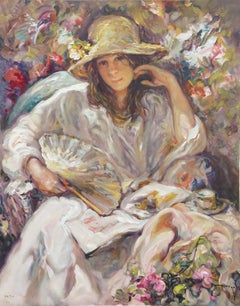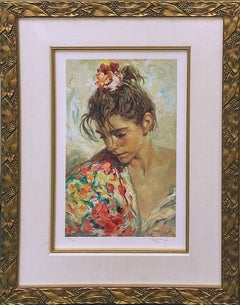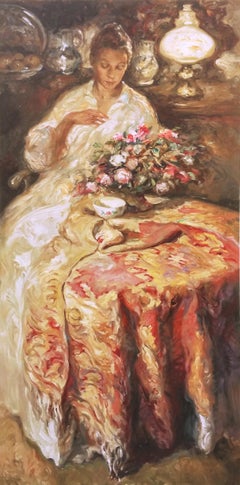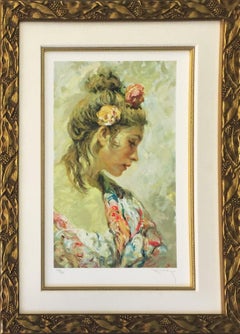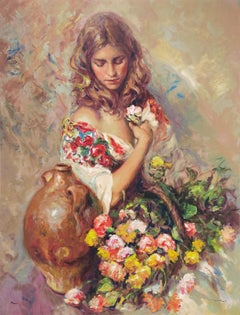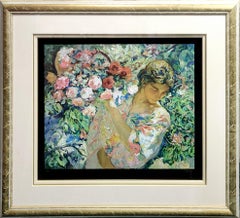José Royo On Sale
SOL Y SOMBRA
By José Royo
Located in Aventura, FL
Serigraph on clayboard panel. Hand signed and numbered by the artist. Edition PA of 14.
Artwork is in excellent condition. Certificate of authenticity included. All reasonable offe...
Category
1990s Impressionist Portrait Prints
Materials
Board, Screen, Clay
EL MANTON
By José Royo
Located in Aventura, FL
From the Shawl Suite. Serigraph on paper. Hand signed and numbered by the artist. Artwork is in excellent condition. Artwork image size: 18 x 11 in. Framed size: approx. 30.5 x 23 i...
Category
1990s Impressionist Portrait Prints
Materials
Paper, Screen
INVIERNO
By José Royo
Located in Aventura, FL
Serigraph on clayboard panel. Hand signed and numbered by the artist. Edition PA of 15.
Artwork is in excellent condition. Certificate of authenticity included. All reasonable offer...
Category
20th Century Impressionist Portrait Prints
Materials
Board, Screen, Clay, Panel
CLAVELES II
By José Royo
Located in Aventura, FL
From the Shawl Suite. Serigraph on paper. Hand signed and numbered by the artist. Artwork is in excellent condition. Artwork image size: 18 x 11 in. Framed size: approx. 30.5 x 23 i...
Category
1990s Impressionist Portrait Prints
Materials
Paper, Screen
Recent Sales
SENTIMIENTO
By José Royo
Located in Aventura, FL
Serigraph on clay board panel. Hand signed and numbered by the artist. Edition of 240.
Artwork is in excellent condition. Certificate of authenticity included. All reasonable offer...
Category
1990s Impressionist Portrait Prints
Materials
Clay, Board, Screen
JOVEN CON CESTO DE FLORES
By José Royo
Located in Aventura, FL
Serigraph on paper. Hand signed and numbered by the artist. Black edition of 150. Artwork image size 23.5 x 28.5 inches. Framed size approx. 40.5 x 45 inches.
Artwork is in excell...
Category
1990s Contemporary Portrait Prints
Materials
Paper, Screen
SENTIMIENTO
By José Royo
Located in Aventura, FL
Serigraph on clay board panel. Hand signed and numbered by the artist. Edition of 240.
Artwork is in excellent condition. Certificate of authenticity included. All reasonable offer...
Category
1990s Impressionist Portrait Prints
Materials
Clay, Board, Screen
La Joya
By José Royo
Located in Saint Augustine, FL
An original signed serigraph by Spanish artist Royo (1945-) titled "La Joya", 2003. From the regular edition on white museum board paper of 145, (116/145). Hand signed and numbered b...
Category
21st Century and Contemporary Impressionist Portrait Prints
Materials
Screen
People Also Browsed
Clairtone Project G2 Series T11 Console Stereo System & Garrard Turntable
By Clairtone
Located in Vancouver, British Columbia
On offer is a rare completely original Clairtone G2 Series Home Stereo System from 1966 featuring two distinct exotic wooden boxes one that houses the tuner and the turntable both pr...
Category
Vintage 1960s Canadian Mid-Century Modern Musical Instruments
Materials
Aluminum
$30,000
H 24.25 in W 78.5 in D 9.25 in
GOLDEN GIRL
By LeRoy Neiman
Located in Aventura, FL
Hand signed numbered by the artist in pencil. Artwork size: 24.25 x 30 in. Frame size: approx. 37 x 43 in. Artwork appears to be in excellent condition. Artwork has not been examine...
Category
1980s Impressionist Portrait Prints
Materials
Paper, Screen
Suggestive Nude of a Woman oil on canvas painting
Located in Sitges, Barcelona
Technical Sheet
Title: "Suggestive Nude of a Woman"
Artist: Rosendo González Carbonell (1910-1985)
Technique: Oil on canvas
Dimensions: 36.2 x 28.7 inches
Framing: Unframed
Signed: Y...
Category
1970s Impressionist Nude Paintings
Materials
Canvas, Oil
$958 Sale Price
50% Off
H 36.23 in W 28.75 in
Winter landscape of melting snow and reflective evening sunset, Oil on Canvas
By Edvard Rosenberg
Located in Naples, Florida
Edvard Axel Rosenberg (Swedish School, 1858-1934)
In many ways Edvard Rosenberg was the archetypal Swedish painter, he was born in Stockholm in 1...
Category
Early 20th Century Impressionist Landscape Paintings
Materials
Oil
$6,760 Sale Price
20% Off
H 30 in W 44 in
Tiffany Studios “Tyler” Table Lamp
By Tiffany Studios
Located in Dallas, TX
Tiffany Studios New York Tyler Leaded Glass and Patinated bronze Table Lamp, Circa 1900 Art Nouveau.
A very special lamp with a geometric monochromatic deep green art glass surround...
Category
Antique Early 1900s American Art Nouveau Table Lamps
Materials
Bronze
The Letter, young lady in her boudoir 19th Century majestic miniature painting
Located in Norwich, GB
A majestic miniature painting by Victor Mongodin. Painted with extraordinary detail, it depicts a pretty young lady writing a letter in her boudoir. Mongodin clearly delights in pain...
Category
1860s French School Interior Paintings
Materials
Oil, Wood Panel
$1,250
H 11.42 in W 9.45 in D 0.4 in
12 Exceptional Steuben Baluster Water Goblets c1940 American
By Steuben Glass
Located in Litchfield, CT
Circa 1940, by the Steuben Glass Works, Corning, NY. Known as the #7877 baluster stem, this is the most coveted of all modernist glasses. Intended as a water glass, today these gobl...
Category
Vintage 1940s American Crystal Serveware
Materials
Crystal
Early 18th Century Needlework Picture Depicting Angels
Located in Chelmsford, Essex
Early 18th Century Antique Silkwork Embroidery Picture. The embroidery is worked in silk on linen ground, in tent stitch or petit point. Colours pinks, blues, cream, gold, greens and...
Category
Antique 1730s Tapestries
Materials
Silk
French Club Chairs in Brown Upholstery
Located in Waalwijk, NL
Pair of club chairs, brown fabric, beech, brass, France, 1940s.
These classically sculpted armchairs feature seatings that are designed as a shell, which embraces the sitter wonderf...
Category
Vintage 1940s French Art Deco Armchairs
Materials
Brass
Low Country (South Carolina)
By Elizabeth Verner
Located in Middletown, NY
An enchanting Southern landscape by the mother of the Charleston Renaissance.
A native of Charleston, South Carolina, and educated under the tutelage of Thomas Anshutz at The Pennsy...
Category
Early 20th Century American Modern Landscape Prints
Materials
Archival Paper, Drypoint, Etching
Pillowcase Made from an Antique European Embroidery, Late 20th Century.
Located in Istanbul, TR
It does not come with an insert but a bag made to the size to accommodate insert materials.
Linen in the back.
Zipper closure.
Dry cleaning is recommended.
Category
Early 20th Century English Pillows and Throws
Materials
Wool
$475
H 13.78 in W 38.19 in D 0.2 in
Large Victorian 19th Century Stained Glass Window
Located in Wormelow, Herefordshire
An antique Victorian late 19th century stained glass window, originally from a church in northern England. Three hand painted detailed flowers, thought to be Tudor Rose, sit at the h...
Category
Antique Late 19th Century English Victorian Windows
Materials
Glass, Stained Glass, Wood, Pine
Paris Porcelain Botanical Vases, French, Mid-19th Century
By Old Paris
Located in Downingtown, PA
Pair of large Paris Porcelain Botanical Vases,
Mid-19th century.
Each of the baluster form vases has a cylindrical neck and everted rim and is painted with floral bouquets on a whit...
Category
Antique Mid-19th Century French Victorian Vases
Materials
Porcelain
Art Nouveau Allegory of Germany Portrait Vase by Kannhäuser for RStK Amphora
By Nikolaus Kannhäuser, Reissner Stellmacher & Kessel
Located in Chicago, US
Model #2011
Note: We highly recommend shipping through 1stDibs for its cost effectiveness, full insurance coverage, and reliable handling. While standard parcel services are an opti...
Category
Antique 1890s Austrian Art Nouveau Vases
Materials
Porcelain
$12,900
H 16.5 in W 6 in D 6 in
Barques au Bois de Boulogne - Fauvist Landscape Oil Painting by Louis Valtat
By Louis Valtat
Located in Marlow, Buckinghamshire
Signed fauvist oil on canvas laid on panel riverscape circa 1925 by French painter Louis Valtat. The work depicts several boats being rowed on River Seine in Bois de Boulogne - a for...
Category
1920s Fauvist Landscape Paintings
Materials
Oil, Panel, Canvas
Twelve Framed Minton & Co. Tiles Designed by Walter Crane
By Minton
Located in Wormelow, Herefordshire
A rare group of twelve 19th century ceramic Minton & Co. tiles in later frames, depicting the artistic retelling of nursery rhymes by English illustrator, Walter Crane (1845-1915). T...
Category
Antique Late 19th Century English Victorian Decorative Art
Materials
Ceramic, Wood
Get Updated with New Arrivals
Save "Jose Royo On Sale", and we’ll notify you when there are new listings in this category.
More Ways To Browse
Vicente Cristellys
William Gaw
1700s Dress
1800 American Oil Paintings
1960s Rock Posters
A H Vickers Oil Painting
Aaron Bushnell
Aaron Foster
Abbott Fuller Graves
Abraham Rosenthal
Agudo Clara
Alan Halliday
Albert Anderson Clymer On Sale
Albert Auguste Fourie
Albert Fourie
Albert Ludovici
Alberto Ulloa
Alexander Calder Postcard
